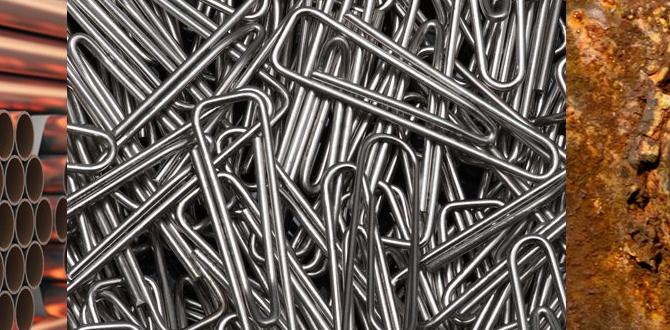Yes, you can successfully dry cut Inconel 625 using a carbide end mill, especially with the right parameters and tool selection. Focus on high-sfm with light axial depth of cut and controlled feed rates to manage heat and vibration for optimal results with reduced neck carbide end mills.
Working with tough materials like Inconel 625 can feel daunting, especially when you’re just starting out. It’s a superalloy known for its incredible strength and resistance to heat and corrosion, which makes it fantastic for demanding applications, but a real challenge to machine. Many machinists shy away from trying to cut it dry, fearing tool breakage or poor surface finish. But what if I told you it’s not only possible but can be quite effective with the right approach? Today, we’re going to demystify dry cutting Inconel 625 with carbide end mills, breaking it down into easy, manageable steps. You’ll learn exactly what you need and how to do it safely and efficiently, even if you’re relatively new to milling these tough alloys.
Understanding Inconel 625 and Dry Cutting
Before we dive into the “how-to,” let’s quickly get acquainted with what we’re dealing with. Inconel 625 is a nickel-chromium superalloy. Think of it as the superhero of metals when it comes to extreme environments – it’s used in jet engines, chemical processing plants, and offshore oil rigs. Its toughness comes from its high nickel content, which allows it to maintain strength at high temperatures and resist corrosive elements. This same toughness, however, makes it work-harden very easily. This means if you’re not careful, the material you just cut can become even harder, dulling your tool much faster and making subsequent cuts even more difficult.
Dry cutting, in this context, means machining Inconel 625 without using any cutting fluids or coolants. While coolants are traditional for softer materials where heat can quickly ruin a tool, dry cutting has advantages, especially for some exotic alloys or in situations where coolant use is undesirable or impractical. For Inconel 625, dry cutting can actually be beneficial because the copious amounts of heat generated tend to vaporize standard coolants. This can lead to issues like built-up edge (BUE) on the cutting tool, which degrades performance and can cause tool failure. When done correctly with appropriate tooling and parameters, dry cutting can promote higher chip temperatures that aid in chip evacuation, and it eliminates coolant-related cleanup and disposal issues. It relies heavily on the tool material and geometry to manage the heat generated.
Why Carbide End Mills for Inconel 625 Dry Cutting?
Carbide, specifically tungsten carbide, is your go-to material for machining Inconel 625, especially when dry cutting. Here’s why:
- High Hardness: Carbide end mills are significantly harder than High-Speed Steel (HSS) tools. This allows them to maintain their edge and cut through tough, work-hardening materials like Inconel 625 without deforming or dulling too quickly.
- Heat Resistance: Carbide can withstand much higher temperatures than HSS. While we aim to manage heat in dry cutting, any tool will get hot. Carbide’s inherent heat resistance means it can survive the elevated temperatures generated by cutting Inconel 625.
- Rigidity: Carbide tools are stiffer than HSS, which helps reduce vibration. Vibration is a major enemy when machining tough alloys, as it leads to poor surface finish and premature tool wear.
For Inconel 625 dry cutting, we often look for specific types of carbide end mills. A popular and effective choice is a carbide end mill with a 3/16 inch (or 8mm shank) and a reduced neck. Why this specific configuration?
- Reduced Neck: The reduced neck design provides extra clearance behind the cutting flutes, which is crucial for chip evacuation. When machining Inconel 625 dry, chips can be sticky. Good chip evacuation prevents chips from re-cutting, which generates more heat and can lead to catastrophic tool failure. The reduced neck allows chips to flow more freely away from the workpiece and the cutting edge.
- Smaller Shank Diameter: For intricate work or when dealing with limited clearance, a 3/16 inch (or 8mm) shank is often practical. It allows for tighter tool paths and can be easier to find in specialized geometries.
- Specific Coatings: Look for carbide end mills with specialized coatings like TiAlN (Titanium Aluminum Nitride) or a similar PVD (Physical Vapor Deposition) coating. These coatings add another layer of hardness, reduce friction, and improve heat resistance, which are all critical for successful dry cutting of Inconel 625.
Essential Tools and Setup
To get started with cutting Inconel 625 dry using your carbide end mill, you’ll need a few key pieces of equipment and a well-prepared setup. Safety is always the top priority in any machining operation.
Your Milling Machine and Workholding
A rigid milling machine is essential. This means a machine with minimal flex in the spindle, column, and table. A well-maintained Bridgeport-style knee mill or a modern CNC milling machine will work best. For smaller hobbyist machines, consider if they have sufficient rigidity for this operation.
Workholding must be exceptionally secure. Inconel 625 can exert significant forces on the workpiece. Use a sturdy vise with hardened jaws, or ideally, custom fixtures that firmly support the material. Ensure the workpiece is seated on a solid base (e.g., parallel stock) and that it cannot lift or shift during the cut.
The Carbide End Mill
As discussed, a high-quality carbide end mill is key. For this specific task, we highly recommend:
- Type: Solid carbide end mill.
- Geometry: Consider end mills with a higher number of flutes (e.g., 4-6 flutes) for better surface finish and heat dissipation, but ensure they have good chip-breaker features or a design that promotes chip evacuation.
- Diameter: If you’re using a 3/16 inch shank, you’ll likely be working with a tool of similar or a slightly larger cutting diameter, or using an end mill where the shank measures 3/16 inch (or 8mm) for clearance.
- Coating: TiAlN, AlTiN, or a similar high-performance coating is highly recommended.
- Edge Prep: A slightly rounded or relieved cutting edge can improve tool life.
Measurement and Inspection Tools
- Calipers/Micrometer: For accurately measuring stock and final dimensions.
- Dial Indicator/Edge Finder: To precisely locate your workpiece zero and ensure it’s correctly positioned in the vise.
- Magnifying Glass/Microscope (Optional but Recommended): To inspect the cutting edge of your end mill for wear or chipping before and after cuts.
Safety Equipment (Non-Negotiable!)
- Safety Glasses: Always wear ANSI- Z87.1 certified safety glasses. Consider a full face shield for added protection.
- Hearing Protection: Milling can be loud.
- Appropriate Clothing: Avoid loose clothing that can get caught in the machine.
- Gloves: Wear cut-resistant gloves when handling sharp tools or rough stock, but never wear loose gloves while the machine is running.
Step-by-Step Guide to Dry Cutting Inconel 625
Now that we have our tools and setup ready, let’s walk through the process. Remember, patience and precision are your best friends here.
Step 1: Secure the Workpiece
Place your Inconel 625 workpiece securely in your milling vise or fixture. Ensure it’s perfectly flat and held tightly. Double-check that the vise jaws are clean and free of debris. If you’re using parallels, make sure they are also clean and provide a solid base. You want zero chance of the material moving during machining.
Step 2: Set Up the Machine and Tool
Install your chosen carbide end mill into a rigid tool holder (e.g., ER collet chuck) and tighten it securely in the milling machine’s spindle. Ensure the tool is run out is minimal, ideally less than 0.0005 inches. You can check this by indicating the tool body as the spindle rotates slowly.
Set your machine’s zero point. Use an edge finder or probe to accurately locate the material’s edge and surface. This ensures your programmed tool path will be exactly where you intend it to be.
Step 3: Determine Cutting Parameters (Feeds and Speeds)
This is perhaps the most critical step for successful dry cutting of Inconel 625. Aggressive parameters will quickly destroy your tool. Gentle, controlled parameters are key. The focus is on achieving a high surface speed (SFM) with a light chip load to keep the heat within the chip itself and evacuate it quickly.
General guidelines for dry cutting Inconel 625 with a coated carbide end mill:
- Surface Speed (SFM): Aim for a relatively high SFM to keep the cutting edge moving fast enough to manage heat and avoid prolonged contact with the material generating heat. A good starting point is often between 150-300 SFM. For a 3/16 inch (0.1875 inch) end mill, this translates to an RPM range of approximately 3000-5000 RPM. (RPM = (SFM 3.25) / Diameter in inches).
- Feed Rate (IPM): This is crucial and needs to be balanced with RPM. A common starting point for the chip load per tooth (CLPT) for Inconel 625 with a 4-fluted carbide end mill is quite small, perhaps in the range of 0.001 – 0.003 inches per tooth (IPT).
- Axial Depth of Cut (DOC): Keep this light. For dry cutting, aim for a very shallow DOC, often no more than 0.050 inches, and sometimes even less, like 0.010 – 0.020 inches, especially for slotting or pocketing.
- Radial Depth of Cut (WOC): For peripheral milling (making a slot or pocket), you can often take a larger radial cut, but for trochoidal milling (a high-efficiency milling strategy), you’ll take a small radial engagement, perhaps 10-20% of the tool diameter.
Here’s a sample calculation for a 3/16 inch (0.1875 inch) 4-flute coated carbide end mill:
- Target SFM: 200 SFM
- RPM Calculation: (200 SFM 3.25) / 0.1875 in = 3467 RPM. Let’s round up to 3500 RPM.
- Target Chip Load Per Tooth (CLPT): 0.002 inches
- Feed Rate Calculation: 3500 RPM 4 flutes 0.002 IPT = 28 IPM.
- Axial DOC: 0.020 inches.
- Radial WOC: Let’s say for a slot, we’re taking a full slot, so we might need a larger diameter tool, or we’d do it in multiple passes. If we’re using a 3/16″ tool, the maximum slot width is 3/16″. Our parameters might need adjustment if needing to cut wider features. For pocketing, a trochoidal strategy with a radial engagement of 0.050″ to 0.100″ might be more appropriate.
Table: Example Start-Up Parameters for 3/16″ Carbide End Mill on Inconel 625 (Dry Cut)
| Parameter | Value | Notes |
|---|---|---|
| Tool Type | Coated Solid Carbide End Mill (e.g., 3/16″ dia, 4 flute) | TiAlN or similar coating recommended. |
| Spindle Speed (RPM) | 3000 – 4000 RPM | Start on the lower end and adjust based on sound. |
| Feed Rate (IPM) | 20 – 30 IPM | Calculate based on RPM and desired chip load (0.001-0.003 IPT). |
| Axial Depth of Cut (DOC) | 0.010 – 0.025 inches | Keep it very shallow. |
| Radial Width of Cut (WOC) | 0.020 – 0.060 inches (for trochoidal milling) | Up to full diameter for facing lighter cuts. |
| Ramp Angle (if applicable) | 3 – 5 degrees | Helps to machine efficiently into the material. |
Always consult your tool manufacturer’s recommendations for their specific end mills. They often provide starting data for various materials. Machining Doctor is a good online resource for calculating Machining Parameters, and resources from the <a href=”https://www.nist.gov/ NIST (The National Institute of Standards and Technology) can also offer valuable material property data.
Step 4: Perform the First Cut
With your parameters set, initiate the cutting process. Start with a small test cut if possible. Listen intently to the sound of the cut. A smooth, consistent whirring sound is good. A harsh, chattering, or grinding sound indicates a problem – often something is too fast or too slow, or there’s too much vibration.
If you hear chatter, try reducing the spindle speed slightly or increasing the feed rate cautiously. If you hear the tool rubbing or “screaming,” you might be going too slow or the depth of cut is too low, causing it to rub rather than cut. If the machine sounds like it’s “laboring,” reduce feed rate or depth of cut.
Pay close attention to chip formation. You want to see small, consistent chips that are being ejected cleanly. Small, powdery chips can indicate rubbing and heat buildup. Long, stringy chips can be a sign of too much feed or too shallow a cut, leading to a built-up edge.
Step 5: Monitor and Adjust
Continue cutting, but take frequent breaks to inspect the tool and the workpiece.
- Tool Inspection: After a few passes, stop the machine and use a magnifying glass to examine the cutting edges. Look for signs of excessive wear, chipping, or a “built-up edge” (material welding onto the cutting edge). If you see any early signs of wear or damage, stop and consider adjusting your parameters, or it might be time for a new tool.
- Surface Finish: Inspect the surface finish of the cut. A good dry cut should leave a relatively smooth, consistent finish. A rough or torn surface can indicate feed rate issues, tool wear, or excessive vibration.
- Temperature: While dry cutting, the workpiece and tool will get hot. You can often gauge the heat by observing the chips; if they are turning blue or have a distinct “burnt” smell, you might be generating too much heat.
Common Adjustments:
- Too much vibration/noise: Reduce spindle speed slightly, lighten the depth of cut, or try a different axial DOC.
- Tool looking dull prematurely: Ensure your feed rate is high enough to achieve a proper chip load, and your SFM isn’t too low. Check that the tool isn’t rubbing.
- Poor surface finish: Often a feed rate issue. Ensure your chip load per tooth is appropriate. Verify spindle speed and tool runout.
- Chips are not evacuating cleanly: Ensure your tool has adequate chip room, and your spindle speed isn’t excessively high, which can lead to recutting. A reduced neck end mill is specifically designed for this.
Step 6: Finishing Touches
Once your main cutting is complete, perform any finishing passes necessary. A finishing pass typically involves a lighter depth of cut and a slightly higher feed rate (while maintaining chip load) at the same SFM to achieve the desired surface finish. For Inconel, sometimes a dedicated finishing-specific end mill with more flutes is beneficial.
After machining, allow the workpiece to cool down before removing it from the machine or touching it, as it will be very hot. Clean the workpiece and your machine to remove any residual chips.
Managing Heat in Dry Cutting
Heat is the primary challenge when dry cutting Inconel 625. While we’re avoiding coolant, we still need to manage the temperature generated. The goal isn’t to








